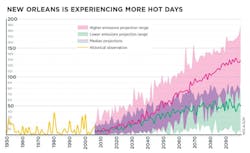New Orleans Unveils Climate Strategy
New Orleans is launching an ambitious effort to cut the city’s greenhouse gas emissions in half by 2030 by way of a roadmap with 11 strategies and 25 concrete actions.
Building upon a June 15 City Council resolution committing to the goals of the Paris Agreement, Mayor Mitch Landrieu issued an executive order adopting Climate Action for a Resilient New Orleans as the guiding policy for the city’s climate commitment.
“Foremost among our city’s urgent threats is climate change, and with it more extreme heat and potential sea level rise that could engulf our city,” Landrieu explains. “If global temperature rises unchecked, New Orleans will not see another 300 years. Already we are seeing more coastal loss than anywhere else in the U.S. and among the fastest in the world.”
Most of the city’s pollution comes from transportation, waste management and energy used for lighting and HVAC, so reduction strategies focus on those areas. By 2030, New Orleanians will use 100% low-carbon electricity, take 50% of trips in modes of travel other than driving and divert 50% of waste from landfills, the comprehensive climate action plan says.
The strategies laid out by Climate Action for a Resilient New Orleans include:
- Reducing carbon-intensive fuel reliance: Phasing out coal, growing a local solar economy, implementing a 100% low-carbon electricity standard that includes renewable portfolio requirements for utilities
- Saving energy sustainably: Holding buildings to performance standards, expanding demand-side energy management
- Increasing infrastructure resilience: Evaluating critical utility energy, sewer and water assets, managing demand without creating more pollution
- Transforming infrastructure to reduce car dependence: Prioritizing connecting mass transit to regional jobs and important services, increasing housing development in areas served by public transit and walking corridors, improving transportation infrastructure for non-car transportation
- Encouraging active transportation: Incentivizing public transit ridership, biking and walking, promoting walkable neighborhoods and transit-oriented development
- Increasing fuel efficiency, clean fuel use and shared-use transportation: Maximizing the public transit fleet’s fuel efficiency, launching bicycle and car-sharing services, expanding access to cleaner vehicles
- Launching a recycling/waste reduction initiative: Boosting recycling rates, piloting an organic waste program, reducing the environmental impact of transporting waste
- Generating value from waste: Exploring new opportunities for solid waste and wastewater (including harvesting methane for fuel), developing a device donation program, exploring zero-waste opportunities
- Growing a low-carbon economy: Promoting sustainable practices and jobs, such as solar installation services
- Enabling data-driven decisions: Utilizing digital tools to prioritize action, design initiatives and engage citizens, surveying the urban forest and planting 40,000 trees, making data publicly available
- Connecting culture with climate action: Engaging local residents, businesses and visitors in climate action
Read more about New Orleans’ plans for 2030 and assess the city’s progress toward its climate goals at www.nola.gov.
An increase in usage of cooling energy is driving up emissions and energy use in New Orleans and contributing to climate change, which could eventually place the city underwater. A new climate policy is aimed at drastically reducing energy use and increasing the city's climate resilience.
